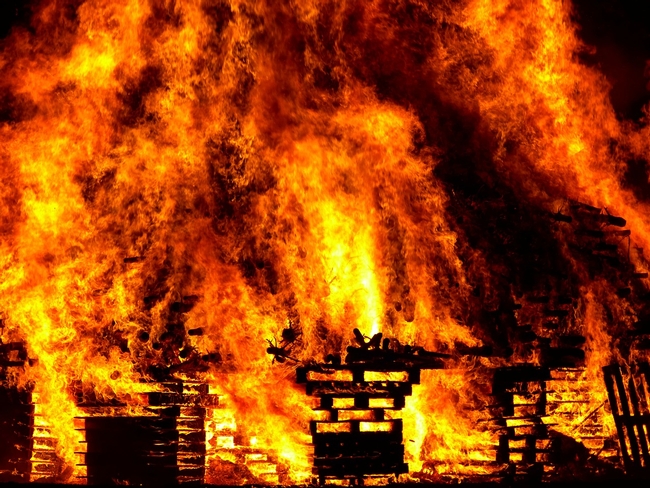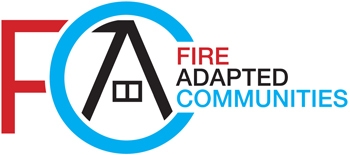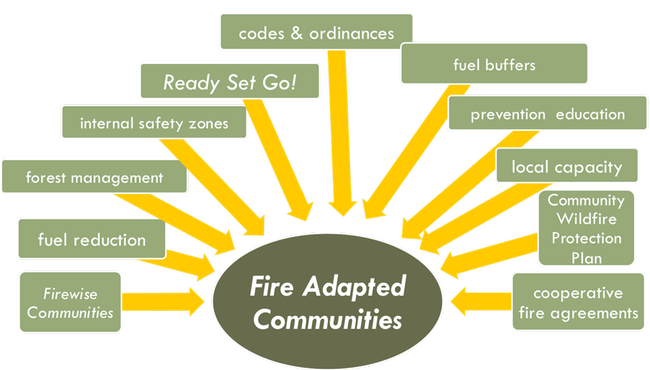
The magnitude of wildfires especially affects those communities that are part of the wildland-urban interface (WUI). Many communities, whose back doors open out into conifer forests, shrub fields or grasslands, have been working towards becoming more resilient and proactive about wildfire. One way is to become a Fire-Adapted Community. A Fire-Adapted Community is a community that can survive a wildfire with little or no assistance from firefighters. The community acknowledges and takes responsibility for this by preparing for a fire at multiple levels including the use of appropriate building construction materials, and proper vegetation management. Members of the community are concerned with safety: safety of the individual, homes and businesses, community infrastructure, open spaces, riparian areas, any and all community assets. They address issues, plan, prepare and work with their local government agencies, fire services and citizenry to reduce their risk if a wildfire comes their way.
There are four elements to a Fire-Adapted Community:
- Community collaboration - Strong fire-adapted communities have a role for everyone. This means that all members of the community (government, schools, businesses, homeowners, renters, fire services, emergency responders, etc.) work together to raise awareness of fire risks and increase knowledge of fire ecology and mitigation actions. This is done through various outreach activities, partnerships and incentives. It also includes completing a Community Wildfire Protection Plan (CWPP) that will assess your community's risk and identify actions to take to lower those risks. It could also involve participating in the Ready Set Go! program which is a collaboration between residents and local fire departments to help people prepare (Ready), understand the threats (Set) and evacuate early (Go) in a fire event.
- Surrounding environment – Fire adapted communities look beyond their fences to see what risks exist and what actions can be taken in the surrounding landscape to reduce those risks. These actions can include fuels reduction projects, improving community ingress and egress and/or the protection and enhancement of riparian and wildlife habitat.
- Planning and regulatory considerations - Fire adapted communities work with their local and state government agencies to ensure that policies, standards and regulations support actions that reduce the risks of wildfire in the community. This may include building codes and standards that encourage the use of non-combustible materials in home construction; the creation of community protection zones that would create a safe environment in the case of resident evacuation; maintaining large turnaround areas for large pieces of equipment; and having a reliable and easily accessible water system.
- Neighborhood, landscapes and buildings - All members of a fire-adapted community work to ensure that their homes, businesses and community assets are prepared in the event of a wildfire. This means reducing flammable materials around homes and businesses; maintaining the immediate landscape and using appropriate, less combustible building and landscaping materials; creating fuel buffers around the community; ensuring that streets and homes are well signed; creating safety zones for residents and animals; having a communication plan – who to call and how to connect if a fire occurs; and designating evacuation routes.
All of these actions taken together, in a collaborative process, help build a strong fire adapted community that is better prepared to face and survive a wildfire.
In the Sierra Nevadas, Incline Village, Nev., is an example of a fire-adapted community. For the past 10 years, they have implemented fuels reduction projects based on their CWPP and involved homeowners and local businesses in planning and implementing mitigation actions. Recently, their goal was to engage a larger audience, build personal connections and recruit new volunteers. Their efforts led to a large gathering where participant input was an essential part of community building and the creation of next steps for the fire adapted community leadership. One participant said that it “Gave me hope that a coordinated, cohesive strategy to prepare our community is seriously underway.”
“I really admire the many active citizens in communities throughout the Sierra Nevada working to reduce wildfire hazards in their neighborhoods," said Susie Kocher, UC Agriculture and Natural Resources forestry and natural resources advisor. "It really will take all of us working together to help our communities become adapted to wildfire.”
Becoming a fire adapted community also means joining a network of people and projects. The Fire Adapted Communities Learning Network is a repository of information and encourages the development and sharing of ideas that can help your community build capacity, raise awareness and take actions towards wildfire resiliency.
For more information on becoming a fire adapted community, or other items mentioned in this blog, please visit:
- Lessons in Community Engagement from North Lake Tahoe
- Becoming a Fire-Adapted Community
- CWPP process
- Fire-Adapted Communities Learning Network
- A Guide to Fire-Adapted Communities
- UCCE Nevada's award winning program
Images courtesy of the National Fire Protection Association.
